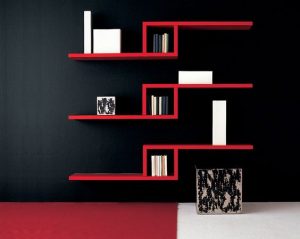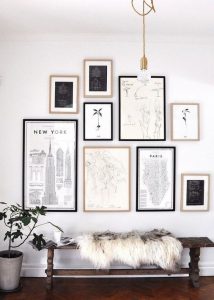Proportion and Scale of Objects in Spaces

In any space, the relationship between the different objects is defined by their proportions. So, to be able to understand this relationship, you need to assess the proportion and scale in the room.
Getting the right balance of sizes between the different objects in a room is important if you want to achieve that sense of harmony which is essential in interior decorating. How you combine the elements in a room will define them.
So, when we use scale to talk about the size of objects, we are also talking about proportions.
The size of a room and where we place the objects within that space are directly related, as everything can be organized according to its characteristics.
Each element in a room has its own meaning and these different elements all depend on one another. So, the way we combine these elements will change the visual effect that they produce.

Human scale
This concept refers to the direct relationship between people and space. Human-scale objects are in proportion with our physical capabilities, and designers avoid creating large-scale monumental objects.
When it comes to arranging objects in our homes, we need to think about the impression we want to create. To do this, it’s important to pay attention to the scale and proportions of every object, and decorate as if we were creating a piece of art.
The main thing to keep in mind when it comes to decorating a space, like for example a living room, is that we are trying to create a sense of balance. The decoration you choose will determine whether it is a pleasant or unpleasant space to spend time in.
Getting the right layout of objects in a living room can be really satisfying, both for you and your guests. It will help to create a welcoming environment that they will enjoy spending time in. When we spend time in a pleasant environment, our subconscious kicks in, and we feel attracted to that space.
When it comes to decorating, it’s much more interesting to create a dynamic space. You don’t always have to create symmetry with your furniture, or use strong structures that convey a sense of stability.
Dynamism
As long as the elements are on the same scale, you can use symmetry to compensate for differing proportions and create a sense of energy and dynamism.
To compensate, you need to get the right amount of space between the different elements.
Take the example of a sofa with a lamp at either end – one a floor lamp, and the other a table lamp. Obviously, they are not the same size, but they have the same scale and proportions, so they help create balance.
Another example might be floating shelves on a wall or above the television. To create energy, you need to place them at different heights, and avoid symmetry with other pieces of furniture.

In both these cases, you can maintain the sense of balance between the different elements, establishing a sense of proportion and creating a strong sense of harmony in the room.
Design is the conscious effort to impose meaningful order.
Proportion in decoration
The aesthetic of decorative elements is directly related to their proportions. The main objective of any designer is to achieve visual harmony in their designs.
Some practical elements, such as door and wardrobe handles need to be placed at the same height throughout your home.
The same goes for paintings and photographs. They should be placed at eye-level. After all, there’s no point in placing them somewhere they’re difficult to see.

Paying attention to these details will help create harmony throughout an entire room. Distributed throughout the room in a logical, ordered and balanced way, there will be a sort of dialogue between the different elements.
When there is no harmony between furniture, our sense of style and taste will try to reject what we see. This will create tension.
When it comes to furniture, another really interesting characteristic is curved ends. They help create energy and are attractive to the eye. Combining curved and straight lines offers numerous possibilities in our homes.
The different lines should complement each other and create a sense of order, so that there is a smooth transition from one element to another. Constantly using the same designs throughout your home isn’t a good look – there needs to be a sense of proportion between people and their furniture.
In any space, the relationship between the different objects is defined by their proportions. So, to be able to understand this relationship, you need to assess the proportion and scale in the room.
Getting the right balance of sizes between the different objects in a room is important if you want to achieve that sense of harmony which is essential in interior decorating. How you combine the elements in a room will define them.
So, when we use scale to talk about the size of objects, we are also talking about proportions.
The size of a room and where we place the objects within that space are directly related, as everything can be organized according to its characteristics.
Each element in a room has its own meaning and these different elements all depend on one another. So, the way we combine these elements will change the visual effect that they produce.

Human scale
This concept refers to the direct relationship between people and space. Human-scale objects are in proportion with our physical capabilities, and designers avoid creating large-scale monumental objects.
When it comes to arranging objects in our homes, we need to think about the impression we want to create. To do this, it’s important to pay attention to the scale and proportions of every object, and decorate as if we were creating a piece of art.
The main thing to keep in mind when it comes to decorating a space, like for example a living room, is that we are trying to create a sense of balance. The decoration you choose will determine whether it is a pleasant or unpleasant space to spend time in.
Getting the right layout of objects in a living room can be really satisfying, both for you and your guests. It will help to create a welcoming environment that they will enjoy spending time in. When we spend time in a pleasant environment, our subconscious kicks in, and we feel attracted to that space.
When it comes to decorating, it’s much more interesting to create a dynamic space. You don’t always have to create symmetry with your furniture, or use strong structures that convey a sense of stability.
Dynamism
As long as the elements are on the same scale, you can use symmetry to compensate for differing proportions and create a sense of energy and dynamism.
To compensate, you need to get the right amount of space between the different elements.
Take the example of a sofa with a lamp at either end – one a floor lamp, and the other a table lamp. Obviously, they are not the same size, but they have the same scale and proportions, so they help create balance.
Another example might be floating shelves on a wall or above the television. To create energy, you need to place them at different heights, and avoid symmetry with other pieces of furniture.

In both these cases, you can maintain the sense of balance between the different elements, establishing a sense of proportion and creating a strong sense of harmony in the room.
Design is the conscious effort to impose meaningful order.
Proportion in decoration
The aesthetic of decorative elements is directly related to their proportions. The main objective of any designer is to achieve visual harmony in their designs.
Some practical elements, such as door and wardrobe handles need to be placed at the same height throughout your home.
The same goes for paintings and photographs. They should be placed at eye-level. After all, there’s no point in placing them somewhere they’re difficult to see.

Paying attention to these details will help create harmony throughout an entire room. Distributed throughout the room in a logical, ordered and balanced way, there will be a sort of dialogue between the different elements.
When there is no harmony between furniture, our sense of style and taste will try to reject what we see. This will create tension.
When it comes to furniture, another really interesting characteristic is curved ends. They help create energy and are attractive to the eye. Combining curved and straight lines offers numerous possibilities in our homes.
The different lines should complement each other and create a sense of order, so that there is a smooth transition from one element to another. Constantly using the same designs throughout your home isn’t a good look – there needs to be a sense of proportion between people and their furniture.







